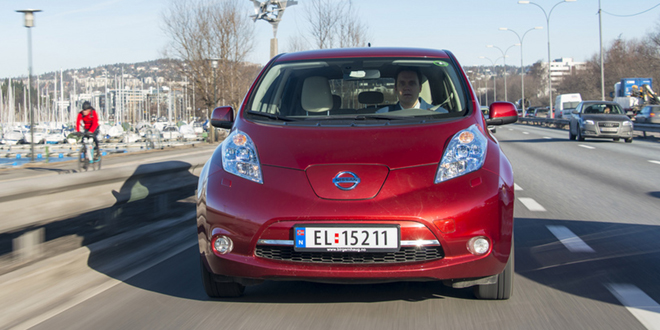EVs may still draw stares in many American cities, but in Norway these days, they don’t merit a second glance. For the last three months, the Model S and the LEAF have been the best-selling cars in the country. Total EV sales are around 1,200 a month, or over 10% of all auto sales.
According to the Guardian, the latest figures suggest that over 21,000 EVs are now registered in the country of 5 million people, compared to around 70,000 all-electric vehicles in the US, with a population of 313 million. Within a year, there could be more EVs in Oslo than in Los Angeles and San Francisco combined.
As in California, the sudden popularity of EVs may have less to do with love of technology or the environment than with generous government-sponsored incentives. Norwegian EV drivers enjoy hefty tax savings, subsidies for home chargers, free tolls, parking and charging, and the right to use bus lanes.
“You can buy a LEAF for 280,000 kroner ($44,688) which compares with 300,000 ($47,880) for a VW Golf. Over 10,000 km, it costs about [$287] to run, but the same for a petrol car would be [$1,277]. On top of that I save [$5.60] a day on tolls, but some people are saving far more,” says Snorre Sletvold, president of the Norwegian Electric Vehicle Association.
“We needed a new family car. We got a LEAF because it was really cheap and we did not want to pollute the air,” says Maren Esmark, CEO of Friends of the Earth Norway. “We felt we were supporting the technology, but the reason why most Norwegians are buying them is because they have a lot of money and can afford two cars, and because they can use them in the bus lanes.”
The Guardian speculates that the Nordic EV boom may not last. The government plans to reevaluate the incentives in 2018, or as soon as 50,000 zero-emission cars have been registered. At the current rate of sales, that could happen within 18 months.
Furthermore, the convenience factor has diminished as EVs have proliferated, clogging bus lanes and overwhelming public charging facilities. The local newspaper Budstikka found that, during a recent rush hour on a busy highway between Oslo and its suburbs, 75% of the vehicles using the bus lane were EVs, and only 7.5% were buses.
Source: The Guardian, Budstikka
Image: Elbilforeningen/Flickr



















































